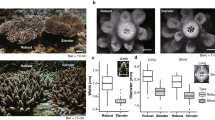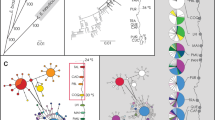Abstract
Patterns of interbreeding between individuals are fundamental to the structure and maintenance of evolutionary boundaries between species. In corals, both hybridisation and reproductive isolation appear to be important evolutionary mechanisms. In this study, I examine evolutionary boundaries using morphological, molecular and reproductive criteria within the Acropora humilis species group at Lizard Island on the Great Barrier Reef, Australia. Five species and seven morphs are recognised on the basis of morphological appearance of features traditionally used to identify corals of the genus Acropora. In a molecular phylogenetic analysis, I examine relationships for the mitochondrial DNA’s putative control region, using maximum-parsimony and maximum-likelihood methods. The reproductive criteria explore whether species and morphs are reproductively isolated on the basis of temporal or fertilisation barriers. Timing of gamete maturity is surveyed for each species and morph, from the month prior to and 3 months after the mass spawning. Time of spawning is documented at the levels of night and hour of spawning, and time taken for egg-sperm bundles to separate. Laboratory fertilisation experiments tested the potential of species and morphs to interbreed. High levels of intraspecific and extremely low or zero fertilisation levels between the five species indicated that they are valid species. Based on the combined assessment of morphological, molecular and reproductive criteria, A. humilis and A. gemmifera appear to be the most closely related species, which are most closely related to the remaining species in the following order: A. samoensis, A. monticulosa and A. digitifera. Evidence derived from one or more of these criteria suggest that the morphs (1) are at various stages of divergence from the species with which they share morphological characters, and (2) may indicate possible zones of speciation and hybridisation. Identification of morphs avoided the possibility of taxonomic error and was essential for accurate interpretation of evolutionary boundaries. Confirmation of morphology as an informative character of evolutionary boundaries is of great significance because most coral research projects rely on morphology as the primary tool for identification of species.





Similar content being viewed by others
References
Arnold ML (1997) Natural hybridization and evolution. Oxford University Press, New York
Avise JC (2000) Phylogeography: the history and formation of species. Harvard University Press, Cambridge
Babcock R (1995) Synchronous multispecific spawning on coral reefs: potential for hybridization and roles of gamete recognition. Reprod Fertil Dev 7:943–950
Babcock RC, Bull GD, Harrison PL, Heyward AJ, Oliver JK, Wallace CC, Willis BL (1986) Synchronous spawnings of 105 scleractinian coral species on the Great Barrier Reef. Mar Biol 90:379–394
Babcock RC, Willis BL, Simpson CJ (1994) Mass spawning of corals on a high latitude coral reef. Coral Reefs 13:161–169
Baird AH, Marshall PA, Wolstenholme J (2002) Latitudinal variation in the reproduction of Acropora in the Coral Sea. In: Moosa MK, Soemodihardjo S, Soegiarto A, Romimohtarto K, Nontji A, Soekarno, Suharsono (eds) Proceedings of the 9th International Coral Reef Symposium, vol 1. Indonesian Institute of Sciences, Indonesia, pp 385–402
Brook G (1891) Descriptions of new species of Madrepora in the collections of the British Museum. Ann Mag Nat Hist 8:458–471
Brook G (1892) Preliminary descriptions of new species of Madrepora in the collections of the British Museum. Part II. Ann Mag Nat Hist 10:451–465
Brüggemann F (1879) Corals in Zoology of Rodriguez. Philos Trans R Soc Lond B 168:569–579
Coll JC, Bowden BF, Meehan GV, Konig GM, Carroll AR, Tapiolas DM, Aliño PM, Heaton A, De Nys R, Leone PA, Maida M, Aceret TL, Willis RH, Babcock RC, Willis BL, Florian Z, Clayton MN, Miller RL (1994) Chemical aspects of mass spawning in corals. I. Sperm-attractant molecules in the eggs of the scleractinian coral Montipora digitata. Mar Biol 118:177–182
Dana JD (1846) Zoophytes. US Explor Exped 7:1–740
Diekmann OE, Bak RPM, Stam WT, Olsen JL (2001) Molecular genetic evidence for probable reticulate speciation in the coral genus Madracis from a Caribbean fringing reef slope. Mar Biol 139:221–233
Fukami H, Omori M, Shimoike K, Hayashibara T, Hatta M (2003) Ecological and genetic aspects of reproductive isolation by different spawning times in Acropora corals. Mar Biol 142:679–684
Gilbert DG (1994) SEQAPP 1.9. A biological sequence editor and analysis program for Macintosh computers. Available from http://ftp.bio.indiana.edu. Cited 14 April 2003.
Harrison PL, Babcock RC, Bull GD, Oliver JK, Wallace CC, Willis BL (1984) Mass spawning in tropical reef corals. Science 223:1186–1189
Hatta M, Fukami H, Wang W, Omori M, Shimoike K, Hayashibara T, Ina Y, Sugiyama T (1999) Reproductive and genetic evidence for a reticulate evolutionary history of mass-spawning corals. Mol Biol Evol 16:1607–1613
Hayashibara T, Shimoike K (2002) Cryptic species of Acropora digitifera. Coral Reefs 21:224–225
Hayashibara T, Shimoike K, Kimura T, Hosaka S, Heyward A, Harrison P, Kudo K, Omori M (1993) Patterns of coral spawning at Akajima Island, Okinawa, Japan. Mar Ecol Prog Ser 101:253–262
Kenyon JC (1997) Models of reticulate evolution in the coral genus Acropora based on chromosome numbers: parallels with plants. Evolution 51:756–767
Knowlton N, Maté JL, Guzmán HM, Rowan R, Jara J (1997) Direct evidence for reproductive isolation among the three species of the Montastraea annularis complex in Central America (Panamá and Honduras). Mar Biol 127:705–711
Lang JC (1984) Whatever works: the variable importance of skeletal and of non-skeletal characters in scleractinian taxonomy. Palaeontogr Am 54:18–44
Márquez LM, van Oppen MJH, Willis BL, Miller DJ (2002a) Sympatric populations of the highly cross-fertile coral species Acropora hyacinthus and Acropora cytherea are genetically distinct. Proc R Soc Lond B 269:1289–1294
Márquez LM, van Oppen MJH, Willis BL, Reyes A, Miller DJ (2002b) The highly cross-fertile coral species, Acropora hyacinthus and Acropora cytherea, constitute statistically distinguishable lineages. Mol Ecol 11:1339–1349
Miller K, Babcock R (1997) Conflicting morphological and reproductive species boundaries in the coral genus Platygyra. Biol Bull 192:98–110
Miller KJ, Benzie JAH (1997) No clear genetic distinction between morphological species within the coral genus Platygyra. Bull Mar Sci 61:907–917
Odorico DM, Miller DJ (1997) Variation in the ribosomal internal transcribed spacers and 5.8S rDNA among five species of Acropora (Cnidaria; Scleractinia): patterns of variation consistent with reticulate evolution. Mol Biol Evol 14:465–473
Oppen MJH van, Hislop NR, Hagerman PJ, Miller DJ (1999) Gene content and organization in a segment of the mitochondrial genome of the scleractinian coral Acropora tenuis: major differences in gene order within the Anthozoan subclass Zoantharia. Mol Biol Evol 16:1812–1815
Oppen MJH van, Willis BL, van Vugt HWJA, Miller DJ (2000) Examination of species boundaries in the Acropora cervicornis group (Scleractinia, Cnidaria) using nuclear DNA sequence analyses. Mol Ecol 9:1363–1373
Oppen MJH van, McDonald BJ, Willis B, Miller DJ (2001) The evolutionary history of the coral genus Acropora (Scleractinia, Cnidaria) based on a mitochondrial and a nuclear marker: reticulation, incomplete lineage sorting, or morphological convergence? Mol Biol Evol 18:1315–1329
Oppen MJH van, Catmull J, McDonald BJ, Hislop NR, Hagerman PJ, Miller DJ (2002a) The mitochondrial genome of Acropora tenuis (Cnidaria; Scleractinia) contains a large group I intron and a candidate control region. J Mol Evol 55:1-13
Oppen MJH van, Willis BL, van Rheede T, Miller DJ (2002b) Spawning times, reproductive compatibilities and genetic structuring in the Acropora aspera group: evidence for natural hybridization and semi-permeable species boundaries in corals. Mol Ecol 11:1363–1376
Palumbi SR (1994) Genetic divergence, reproductive isolation, and marine speciation. Annu Rev Ecol Syst 25:547–572
Posada D, Crandall KA (1998) MODELTEST: testing the model of DNA substitution. Bioinformatics 14:817–818
Rieseberg LH (1997) Hybrid origins of plant species. Annu Rev Ecol Syst 28:359–389
Rieseberg LH, Archer MA, Wayne RK (1999) Transgressive segregation, adaptation and speciation. Heredity 83:363–372
Saiki RK, Scharf S, Faloona F, Mullis KB, Horn GT, Erlich HA, Arnheim N (1985) Enzymatic amplification of β-Globin genomic sequences and restriction site analysis for diagnosis of sickle cell anemia. Science 230:1350–1354
Stobart B (2000) A taxonomic reappraisal of Montipora digitata based on genetic and morphometric evidence. Zool Stud 39:179–190
Stobart B, Benzie JAH (1994) Allozyme electrophoresis demonstrates that the scleractinian coral Montipora digitata is two species. Mar Biol 118:183–190
Swofford DL (2002) PAUP*. Phylogenetic Analysis Using Parsimony (* and other methods). Sinauer, Sunderland, Mass.
Szmant AM, Weil E, Miller MW, Colón DE (1997) Hybridization within the species complex of the scleractinian coral Montastraea annularis. Mar Biol 129:561–572
Veron JEN (1995) Corals in space and time: the biogeography and evolution of the Scleractinia. UNSW Press, Sydney
Veron JEN, Wallace CC (1984) Scleractinia of eastern Australia. Part V. Family Acroporidae. Australian National University Press, Canberra
Vollmer SV, Palumbi SR (2002) Hybridization and the evolution of reef coral diversity. Science 296:2023–2025
Wallace CC (1985) Reproduction, recruitment and fragmentation in nine sympatric species of the coral genus Acropora. Mar Biol 88:217–233
Wallace CC (1999) Staghorn corals of the world: a revision of the coral genus Acropora (Scleractinia; Astrocoeniina; Acroporidae) worldwide, with emphasis on morphology, phylogeny and biogeography. CSIRO Publishing, Collingwood
Wallace CC, Willis BL (1994) Systematics of the coral genus Acropora: implications of new biological findings for species concepts. Annu Rev Ecol Syst 25:237–262
Willis BL (1990) Species concepts in extant scleractinian corals: considerations based on reproductive biology and genotypic population structures. Syst Bot 15:136–149
Willis BL, Babcock RC, Harrison PL, Oliver JK (1985) Patterns in the mass spawning of corals on the Great Barrier Reef from 1981 to 1984. In: Delesalle B, Galzin R, Salvat B (eds) Proceedings of the 5th International Coral Reef Congress,vol 4. Antenne Museum—EPHE, Moorea, pp 343–348
Willis BL, Babcock RC, Harrison PL, Wallace CC (1997) Experimental hybridization and breeding incompatibilities within the mating systems of mass-spawning reef corals. Coral Reefs 16 [Suppl]:S53–S65
Wolstenholme JK, Wallace CC, Chen CA (2003) Species boundaries within the Acropora humilis species group (Cnidaria; Scleractinia): a morphological and molecular interpretation of evolution. Coral Reefs 22:155–166
Acknowledgements
I thank B. Kojis for sharing her observations of the protracted spawning time in species of Acropora at Lizard Island. I also thank the staff of the Lizard Island Research Station, S. Romano, K. Michalek-Wagner, P. Detwiler, X. Pochon, K. Martin, M. Lalor, K. Tutt, M. Brown, J. MacKenzie, M. Kospartov, J. Stenstrom, D. Richards and Z. Richards for field assistance, and S. Klanten and students in the Institute of Zoology, Academia Sinica for laboratory support. T. Hughes, C. Wallace, C. Chen, L. van Herwerden, P. Munday and four anonymous reviewers provided useful comments on the manuscript. This study was funded by the Lizard Island Doctoral Fellowship and grants from the Australian Coral Reef Society and James Cook University awarded to J. Wolstenholme. Molecular laboratory expenses were funded by an NSC grant and internal funding from Academia Sinica awarded to C. Chen. The research conducted in this project complies with the current laws of Australia.
Author information
Authors and Affiliations
Corresponding author
Additional information
Communicated by M.S. Johnson, Crawley
Rights and permissions
About this article
Cite this article
Wolstenholme, J.K. Temporal reproductive isolation and gametic compatibility are evolutionary mechanisms in the Acropora humilis species group (Cnidaria; Scleractinia). Marine Biology 144, 567–582 (2004). https://doi.org/10.1007/s00227-003-1209-2
Received:
Accepted:
Published:
Issue Date:
DOI: https://doi.org/10.1007/s00227-003-1209-2




